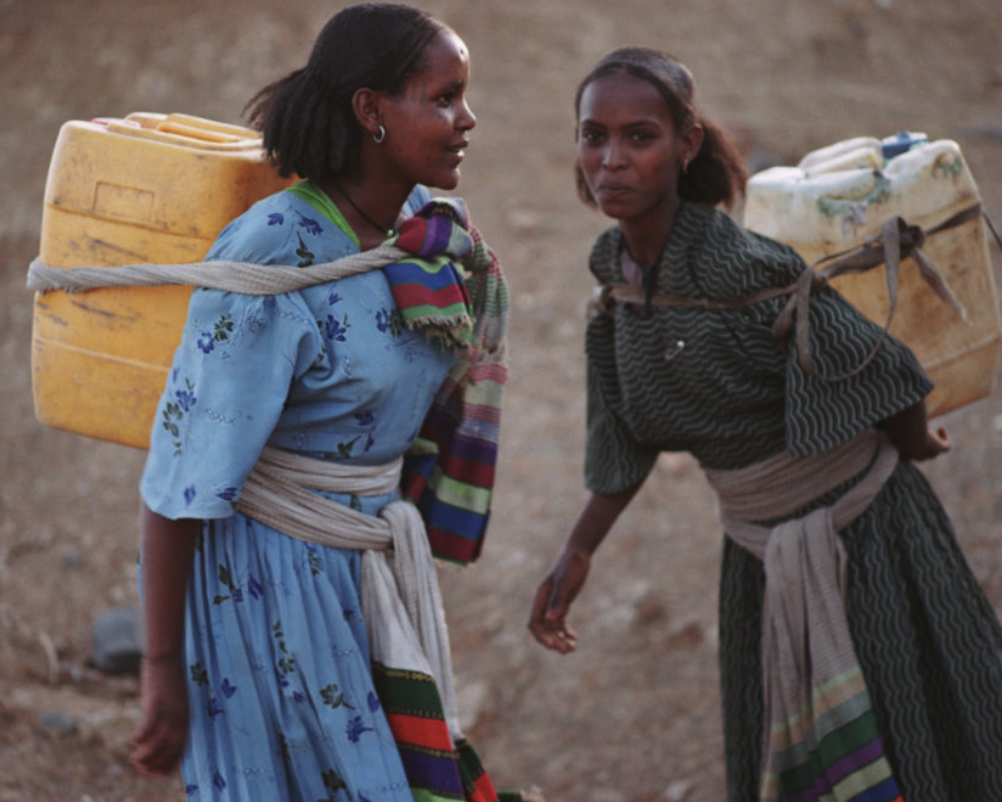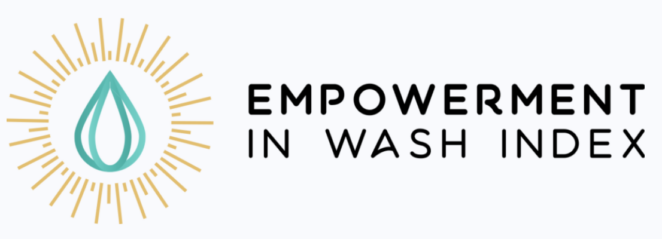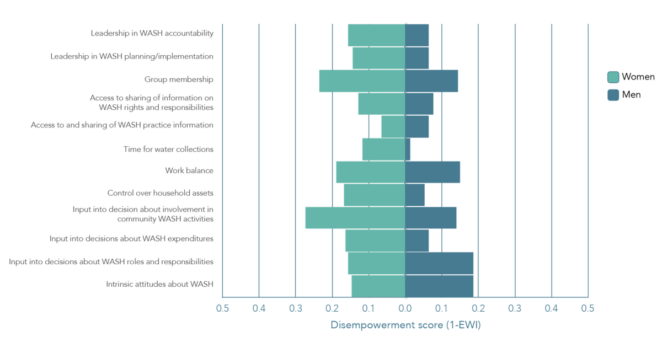Empowerment in WASH Index Tool

This tool is part of theSEIUrban Toolbox for Liveable Citieswhichhas been developed by theSEI Initiative on City Health and Wellbeing.The Urban Toolbox isa collection of tools, developed within SEI or in coordination with SEI,aimed at supporting planning and decision-making for improving the health, well-being and resilience of city residents and urban systems more broadly.
GO TO THE SEI URBAN TOOLBOX FOR LIVEABLE CITIES HOME PAGE
About this tool
What is the EWI tool?
The Empowerment in WASH Index (EWI) is a survey-based tool designed to measure agency, participation and empowerment in the water and sanitation sector. The EWI can be used as a diagnostic or monitoring tool to assess gender outcomes of water, sanitation and hygiene (WASH) interventions and monitor changes in empowerment from an initial baseline and throughout a WASH programme. The outputs from the tool can be used to design more inclusive WASH interventions and policies that address gender disparities and promote empowerment, and which ultimately lead to gender and social equality outcomes in the WASH sector.
*This Urban Toolbox article is an abridged version of the original texts, which can be downloaded from the right-hand column and accessed on the SEI and EWI websites. Please access the original texts for more detail, research purposes, full references, or to quote text.

How does this tool work?
The EWI tool is based on a multi-level conceptualisation of empowerment, and uses indicators that are combined to assess empowerment across multiple levels and dimensions.
The tool is comprised of 12 indicators that help generate empowerment profiles of men and women within the same household. The tool shows the proportion of empowered women and men, as well as their level of empowerment in the context of water, sanitation, and hygiene in a specific setting.
The EWI is calculated on the respondents’ level of achievement on each of the 12 indicators. Individuals who meet at least 75% of the indicators are considered empowered. In this way, even if a respondent scores highly on one indicator, they may still be viewed as having little or no power in other areas.

Measuring empowerment in WASH. Policy brief. IRC (2019)” />
Who might use this tool?
Policy-makers, practitioners, development organizations, governments and donors can use the tool to monitor and evaluate WASH initiatives, or in the planning and design of interventions.
EWI can also be used by researchers interested in investigating pathways between empowerment and WASH services or other development outcomes such as those related to health and wellbeing.
Which stakeholders are involved?
Local communities; male and female household decision makers; local authorities; community leaders; WASH practitioners; other NGOs; researchers
What stage of the process does this tool support?
- Identifying problem areas
- Design and implementation of WASH interventions and policies
- Monitoring and evaluation of existing WASH interventions
- Generating knowledge and solutions
Tool overview
The WASH sector is known for focusing primarily on water and sanitation infrastructure, and the technical standards related to public health outcomes. This emphasis has led policy-makers and practitioners to overlook other aspects of human wellbeing such as gender and social equality (Dickin et al., 2021). The Empowerment in WASH Index (EWI) tool tries to address this gap by measuring gender-sensitive empowerment outcomes and processes in WASH interventions and expand the technical approach that is mainstream in the field (Dery et al., 2020).
Method:
The approach for constructing the EWI was adapted from the Women’s Empowerment in Agriculture Index (WEAI). This approach calculates who is empowered, and how much they are empowered, to create a comparable index (Alkire et al., 2013).
The tool is comprised of 12 indicators that help generate empowerment profiles of men and women within the same household. The tool shows the proportion of empowered women and men, as well as their level of empowerment in the context of water, sanitation, and hygiene in a specific setting.
The indicators include information about WASH roles and responsibilities at the individual, household and community level, as well as in relation to local service providers and broader measures of societal empowerment; as described below:
- Individual: this indicator assesses whether respondents believe they could make their own decisions if they wanted to, regardless of who currently makes household decisions. Assessment at this level focuses on domestic water collection and management, expenditures, and participation outside the household.
- Household: includes indicators focused on instrumental agency, relating to power to make decisions on WASH roles and responsibilities, expenditures, and participation in community activities. Other indicators assess control of assets and workload, which influence ability to participate in decision-making or achieve desired goals. Indicators also measure access to WASH-related information and sharing of that information within the household, such as information on citizens’ rights to WASH services.
- Community: these indicators measure whether respondents feel comfortable speaking up in public on implementation of WASH services, or to make complaints to local leaders or authorities about services. Group membership is also assessed; that is, the extent to which people are involved in community associations.
The EWI is calculated on the respondents’ level of achievement on each of the 12 indicators. A respondent is scored for their achievement on a particular indicator if they reach a certain threshold. In this way, even if a respondent scores highly on one indicator, they may still be viewed as having little or no power in other areas. Individuals who meet at least 75% of the indicators are considered empowered. The EWI score can also be disaggregated to track progress on particular indicators. Additionally, A comparison between empowerment scores for men and women from the same household is conducted to calculate a gender parity index (GPI).
Application: EWI case study examples
Using EWI to strengthen gender dimensions in Asutifi North District WASH master plan, Ghana:this case study gives an insight into how EWI can be applied to inform and improve government plans and achieve SDG 6.
Using EWI to inform the implementation of a WASH master plan in the municipality of Banfora, Burkina Faso:this case study combines EWI with a Pearson’s chi-squared test to explore empowerment in WASH services and relationships between different indicators.
Capabilities and resources required
- Advanced knowledge of quantitative methods is required to analyse the data from the tool. Use of STATA or R is recommended for the final analysis.
- Trained enumerators who can maintain and carry out the survey in the local community.
- The survey can be conducted using mobile phone applications, in which case reliable access to such technology is required. The use of open source ODK Collect app such as Kobo Collect or mWater is recommended.
Implementation tips: key enablers and potential barriers
The question of whether improvement in WASH acts as a source of empowerment for women and girls in different contexts, is still lingering. It is often difficult to attribute causality between a WASH intervention and empowerment because gender relations are embedded and mediated by other cultural and social norms that are difficult to account for, such as ethnicity (Bisung & Dickin 2019). Therefore, researchers should aim to undertake further research to understand how other areas of life, including entrenched cultural gender norms and social norms influence the results of the tool within the given context.
Potential integration with other tools
The EWI is a standalone tool. Nonetheless, the tool can be integrated within a larger survey.
Suggested Citation:
Dickin, S. and Bisung, E. (2019). Empowerment in WASH Index. SEI Discussion Brief, Oct. 2019. Stockholm Environment Institute, Stockholm.
(0) Comments
There is no content